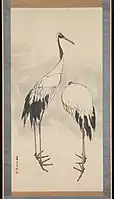Nagasawa Rosetsu
Nagasawa Rosetsu (長沢芦雪, 1754–1799) was an 18th-century (Edo period) Japanese painter of the Maruyama School, known for his versatile style. He was born to the family of a low-ranking samurai. He studied with Maruyama Ōkyo in Kyoto.[1][2]
Nagasawa Rosetsu | |
|---|---|
_and_Eagle_on_a_Branch_(Rosetsu_reverse)_-_2000.73A-D_-_Indianapolis_Museum_of_Art.jpg.webp) Eagle on a Branch, painted on a screen. Edo Period, 18th century. Indianapolis Museum of Art. | |
| Born | 1754 |
| Died | 1799 |
| Nationality | Japanese |
Biography
There are conflicting versions of Rosetsu's family origins, but the most credible appears to be that he was born to the family of a low-ranking samurai named Uesugi Hikouemon in the area of modern Kyoto Prefecture. Upon establishing himself as an artist, he changed his name from Uesugi to Nagasawa. He moved to Kyoto in 1781, where he became a student of Maruyama Ōkyo.
Rosetsu was married and had four children, all of whom died in childhood. He adopted his pupil Nagasawa Roshū.
Rosetsu died in 1799, allegedly by murder.[3] He was said to have been poisoned, although others claim he committed suicide. He, his children, and his pupil are buried in a Kyoto cemetery belonging to the Pure Land Sect, although Rosetsu was a lay student of Zen.[4]
Works

Rosetsu's early period works are in the style of Maruyama Ōkyo, although critics agree that the pupil's skill quickly surpassed his master's. Finally, they had a falling out and Rosetsu left the school. After the break, he worked under the patronage of the feudal lord of Yodo and accepted commissions at several temples.
Rosetsu's paintings fall into two very clearly defined categories, with no halfway stage in between. On the one hand, there are those of studied finish, and on the other, those--the great majority--that were clearly the work of a very few minutes of intense activity, whatever the preliminary thought and calculation. We are inclined to think of the first type as early and even untypical, but in fact Rosetsu seems to have executed carefully finished paintings at all stages of his career.[5]
In his work, which is reminiscent of earlier Zen painting,[6] while the moon is left white, the night sky, mountains, and pine trees are depicted with gradations of India ink.
His work was extensively forged in the Meiji period.
His works are kept in many museums worldwide, including the Dallas Museum of Art,[7] the Walters Art Museum,[8] the Indianapolis Museum of Art,[9] the Princeton University Art Museum,[10] the Harvard Art Museums,[11] the Los Angeles County Museum of Art,[12] the University of Michigan Museum of Art,[13] the British Museum,[14] the Brooklyn Museum,[15] the Tokyo Fuji Art Museum,[16] the Frances Lehman Loeb Art Center at Vassar College,[17] the Cleveland Museum of Art,[18] BAMPFA,[19] the Birmingham Museum of Art,[20] the Minneapolis Institute of Art,[21] the Seattle Art Museum,[22] and the Asian Art Museum.[23]
Gallery
.jpg.webp) White Elephant and Black Bull (left panel)
White Elephant and Black Bull (left panel).jpg.webp) White Elephant and Black Bull (right panel)
White Elephant and Black Bull (right panel) Tiger, Important Cultural Property
Tiger, Important Cultural Property Herd Boys
Herd Boys Monkey on a Rock
Monkey on a Rock
.jpg.webp) Detail of a Tiger
Detail of a Tiger Cranes
Cranes Bird Amid Magnolia and Peony
Bird Amid Magnolia and Peony Carp
Carp Drinking Festival of the Eight Immortals
Drinking Festival of the Eight Immortals
 Landscapes with the Chinese Literati Su Shi and Tao Qian, section two
Landscapes with the Chinese Literati Su Shi and Tao Qian, section two A Jellyfish Like the Moon
A Jellyfish Like the Moon Chinese Beauty
Chinese Beauty
See also
References
- Roberts, Laurance (1976). A Dictionary of Japanese Artists. Tokyo and New York: Weatherhill. p. 131. ISBN 0-8348-0113-2.
- Discovering the Arts of Japan: A Historical Overview by Tsuneko S. Sadao, Stephanie Wada, and Tomoko Miho (2003) p.214
- Singer, Robert, T. (1998). Edo, Art in Japan 1615-1868. Washington, D.C.: National Gallery of Art, Washington. p. 97. ISBN 0-89468-226-1.
{{cite book}}: CS1 maint: multiple names: authors list (link) - Moes, Robert (1973). Rosetsu: Exhibition of Paintings by Nagasawa Rosetsu. Denver, Colorado: Denver Art Museum. pp. 95–98.
- Hillier, Jack (1974). The uninhibited brush: Japanese art in the Shijō style. London: Hugh M. Moss Ltd. pp. 58–66. ISBN 0902717065.
- Zen in Ten: Easy Lessons for Spiritual Growth (Ten Easy Lessons Series, 2) by C. Alexander, Ph.D. Simpkins and Annellen M., Ph.D. Simpkins (2003) p.69
- "Nachi Waterfall - DMA Collection Online". www.dma.org. Retrieved 2021-01-11.
- "Puppies under a Maple Branch". The Walters Art Museum. Retrieved 2021-01-11.
- "Carp in Waves (Zeshin) and Eagle on a Branch (Rosetsu reverse)". Indianapolis Museum of Art Online Collection. Retrieved 2021-01-11.
- "Bamboo under the Moonlight (2008-1081)". artmuseum.princeton.edu. Retrieved 2021-01-11.
- Harvard. "From the Harvard Art Museums' collections Puppies with Hotei and Jittoku". harvardartmuseums.org. Retrieved 2021-01-11.
- "Fish Head | LACMA Collections". collections.lacma.org. Retrieved 2021-01-11.
- "Exchange: Owl and Moon". exchange.umma.umich.edu. Retrieved 2021-01-11.
- "hanging scroll; painting | British Museum". The British Museum. Retrieved 2021-01-11.
- "Brooklyn Museum". www.brooklynmuseum.org. Retrieved 2021-01-11.
- "Bird and Flowers | Nagasawa Rosetsu | Profile of Works". TOKYO FUJI ART MUSEUM. Retrieved 2021-01-11.
- "Vassar's Museum Acquires Japanese Scroll Painting". The Highlands Current. 2014-12-16. Retrieved 2021-01-11.
- "Monkeys by a Stream".
- "Ink, Paper, Silk: One Hundred Years of Collecting Japanese Art | BAMPFA". bampfa.org. Retrieved 2021-01-11.
- "Swimming Carp, Catfish, and Tortoise Among Reeds". www.artsbma.org. Retrieved 2021-01-11.
- "Strange Mountain in a Moonlit Night, Nagasawa Rosetsu ^ Minneapolis Institute of Art". collections.artsmia.org. Retrieved 2021-01-11.
- "Vegetables and a Wolf Eel". art.seattleartmuseum.org. Retrieved 2021-05-25.
- "Asian Art Museum Online Collection". asianart.emuseum.com. Retrieved 2021-01-11.
- Heritage of Japanese Art by Ichimatsu Tanaka and Masao Ishizawa (1992) p.133
External links
- Bridge of dreams: the Mary Griggs Burke collection of Japanese art, a catalog from The Metropolitan Museum of Art Libraries (fully available online as PDF), which contains material on Nagasawa Rosetsu (see index)
- Nagasawa Rosetsu (wiki-fr)